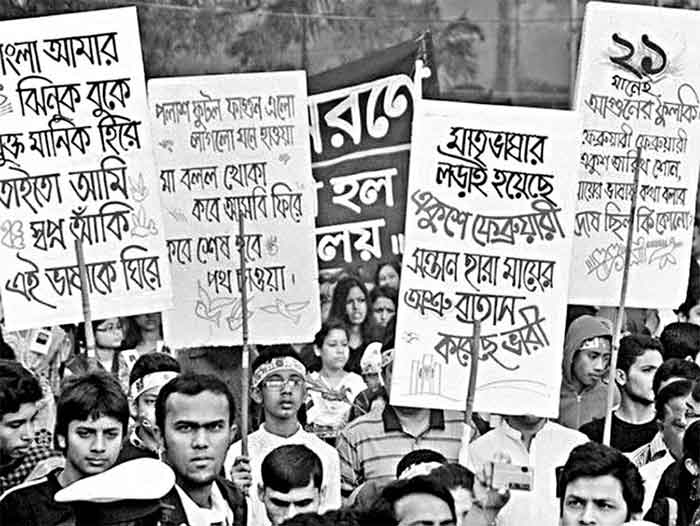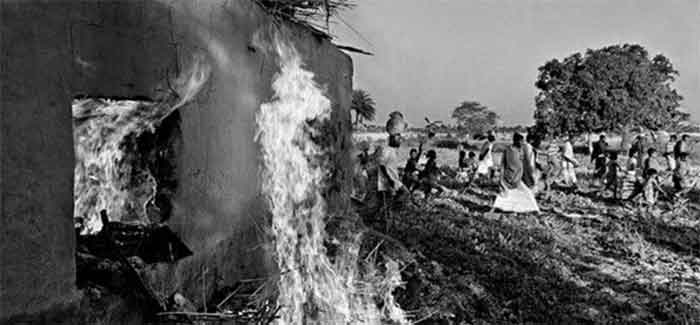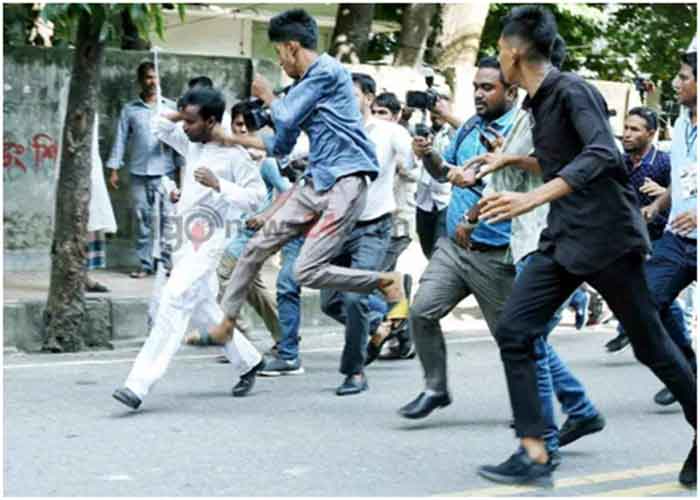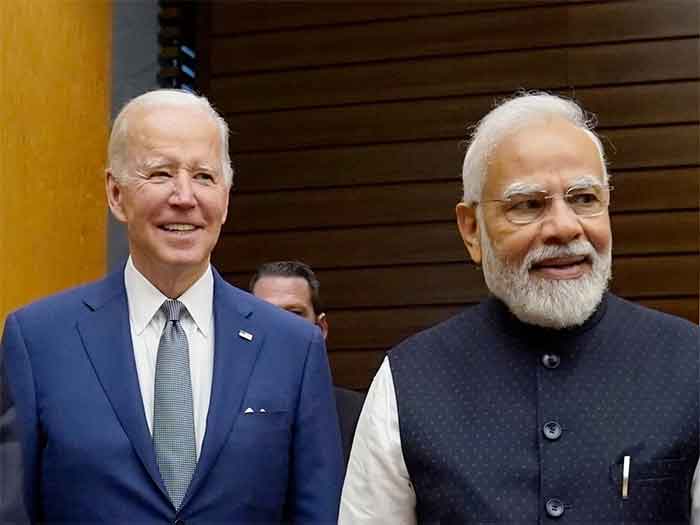
Life, of individual and of class, doesn’t move without contradictions. And, people’s life doesn’t sit immobile. Life and contradiction, thus, is inseparable.
Dynamics in people’s struggle moving on the matrix of class contradictions is complex. Individual ideology and culture, economy, fairy tales and musical instruments and life within home and in production places and markets cannot escape contradictions with respective dynamics. The people in Bangladesh had the same in their life and struggle in the period from the middle of August 1947 to December 1971 — a period of struggle against neo-colonialism and imperialism.
While the classes constituting the people interacted with each other with respective class interests, the people as a whole interacted with its opposite pole — the dominating interests, the ruling regime; the ruling regime had constituents — classes/segments combined with common interests, ruling machine and its parts the common interests assembled, modus operandi and its parts, rules formulated; and these had weaknesses, fractures and historical limitations in the common interests it owned.
The interactions, within camp and between camps, were in different areas, forms, and characters. The areas included economy; the forms included legal and illegal, cooperation, cooption, conflict; and the characters included antagonistic and non-antagonistic.
Culture and class struggle
Culture gets lost whenever it’s defined narrowly, whenever it’s perceived as isolated from class and class struggle. Confining culture only within the areas of literature and arts misses the rest, which is the major part, the part influencing the other part; and the issue of culture cannot be isolated from the issues of basic and superstructures. “Culture is”, writes E P Thompson, “also a pool of diverse resources, in which traffic passes between the literate and the oral, the superordinate and the subordinate, the village and the metropolis; it is an arena of conflictual elements, which requires some compelling pressures — as, for example, nationalism or prevalent religious orthodoxy or class consciousness — to take form as ‘system’. […] [T]he very term ‘culture’, with its cosy invocation of consensus, may serve to distract attention from social and cultural contradictions, from the fractures and oppositions within the whole.” (Customs in Common: Studies in Traditional Popular Culture, The New Press, New York, 1993) Class contradiction reverberates in culture.
Long held aspirations of a people can’t be out-casted from the expanse of culture. These aspirations manifest in the realm of culture. These aspirations include emancipation from exploitation, freedom, recourse to injustice and repression, democratic life, dignity, peace, and prosperity. People keep these aspirations alive from generation to generation. Recourse from natural calamities, economic and financial setbacks, etc, enters into the sphere of culture. Hatred and resistance to highhandedness of/torture by the powerful don’t stay outside of the sphere of culture. These appear not only in forms of song, drama, dance, but also as expression, and in vocabulary and symbol in commoners’ everyday life; and class struggle gets expressed in these forms of and tools used in culture. Bangladeshi people’s cultural and political struggle was not beyond this. It was in struggles in Sunamgang in the north-east part of the land, in Nachol in the western part, in Chittagong in the south-east, in Tongi and in Dhaka in the central region, and in towns around the land. It was among the fighting fishers and farmers, among the struggling industrial workers and students and parts of the middle class.
Pierre Bourdieu in Distinction: A Social Critique of the Judgement of Taste, (tr. Richard Nice, Harvard University Press, Cambridge, Massachusetts, 1996) shows the way classes use culture in respective ways in defining status, and in legitimizing power. In food, literature and art, home decor, etc., Bourdieu observed differences in judgments of taste among classes, which has political significance in a class-divided society.
The Bangladeshi people’s life during that period mentioned above had similar imprint. No landless peasant had the hobby of hunting birds with a single- or double-barreled gun while gun was many big landowners’ a major possession, a tool for security, power, authority, coercion and hobby of hunting. The same was with angling tools and musical instruments — a divide along price and cost, indeed along class. The same was with songs of poor fishers or ferrymen and of money lenders or industrialists. No poor peasant ever dreamed of visiting a belly dancer’s show in the Chambelli Room of Hotel Intercontinental in Dhaka, which was a regular cultural event in the then neo-colonial capital city of the province, East Pakistan, organized for the nouveau riches skimming the broader society and economy. The same was with household possessions and furniture of a so-called village aristocrat or a town-living rich and of a poor toiler living in his home made of mud, jute sticks and tree leaves.
There’s fundamental relation between culture and politics. Ruling classes use culture to impose its ideology for controlling classes hostile to it; and to control, ruling classes manipulate collective, at the class level, and individual, at the micro level, consciousness. Ruling classes regularly use culture to advance and cement its politics among people. This, at times, turns out vulgar melodrama.
The ruling regime manufactures shallow/superfluous/superficial entertainment to distract the masses of people from the ruling regime’s illogic, anomalies, and injustice it perpetrates and the lies it propagates. People’s view, attitude, traditional knowledge, aspirations, perceptions of reality that includes demands for a better, peaceful, dignified and stable life, hostilities of the system, etc, are manipulated in favor of the ruling system. People are kept over-engaged; and, thus, making them tired, so that they can’t reflect their experiences of work, gains, losses, dispossessions, indignity, inequality, etc. It’s manipulation of brain, in Satyajit Ray’s Hirak Raajaar Deshe’s king-speak, magaz dholaai, brainwashing, which leads them to perceive the “reality” ruling classes allow them to perceive.
But, the tact is not Unlimited Inc — without limit and bound. It, with the passage of time, as contradictions sharpen and people’s conscious engagement with class struggle intensifies, turns blunt, ineffective and useless. Consequently, people oppose it. Struggle ensues. It turns out as a contest over political space — a contest between people, the dispossessed, and ruling classes, the exploiters possessing all the rights and riches.
The Bangladeshi people had both the experiences/actions mentioned in the paragraphs above.
Classes, class struggles and contradictions impact and shape culture. At times, political struggle manifests in cultural arena, and it’s through struggle. Culture, at times, turns area of political struggle. Activities related to culture takes political form whenever it mingles with people’s struggles for (1) production and taking share of the production, (2) rights and emancipation, and (3) whenever authorities and its hirelings deny/can’t fulfill people’s demands. The rights include not only basic/fundamental/human rights, but also environmental-ecological and cultural rights. The Bangladeshi people’s culture and struggle went through this interaction during the period.
Culture cannot be considered an object or activity isolated from historical context, and economy, to be specific, mode and relation of production. It’s a folly to define culture suspended from nowhere — as if it grows without a context and without relations. To “critically comprehend a cultural text or practice”, writes John Storey, it has to be located “historically in relation to its conditions of production.” (“Marx and culture”, Culture Matters, March 27, 2018)
Referring to “Marx’s conception of history, contained in the now famous (and often deliberately misunderstood) ‘base/superstructure’ model of historical development”, Storey writes:
“Marx argues that each significant period in history is constructed around a particular ‘mode of production’ […] [E]ach mode of production produces: (i) specific ways of obtaining the necessaries of life; (ii) specific social relationships between workers and those who control the mode of production, and (iii) specific social institutions (including cultural ones). At the heart of this analysis is the claim that how a society produces its means of existence ultimately determines the political, social and cultural shape of that society and its possible future development. [….] .
“The ‘base’ consists of a combination of the ‘forces of production’ and the ‘relations of production’. [….]
“The superstructure consists of institutions (political, legal, educational, cultural, etc.), and what Marx calls ‘definite forms of social consciousness’ (political, religious, ethical, philosophical, aesthetic, cultural, etc.) generated by these institutions. The base ‘conditions’ or ‘determines’ the content and form of the superstructure.” (ibid.)
He explains that the “base also includes social relations and class antagonisms and these also find expression in the superstructure”, and, to take away misunderstanding, cites Frederick Engels’ letter to J Bloch:
“According to the materialist conception of history, the ultimately determining element in history is the production and reproduction of real life. Other than this neither Marx nor I have ever asserted. Hence, if somebody twists this into saying that the economic factor is the only determining one, he is transforming that proposition into a meaningless, abstract, senseless phrase. The economic situation is the basis, but the various elements of the superstructure — political forms of the class struggle and its results, to wit: constitutions established by the victorious class after a successful battle, etc., juridical forms, and even the reflexes of all these actual struggles in the brains of the participants, political, juristic, philosophical theories, religious views and their further development into systems of dogmas — also exercise their influence upon the course of the historical struggles and in many cases preponderate in determining their form. There is an interaction of all these elements in which, amid all the endless host of accidents (that is, of things and events whose inner interconnection is so remote or so impossible of proof that we can regard it as non-existent, as negligible), the economic movement finally asserts itself as necessary. Otherwise the application of the theory to any period of history would be easier than the solution of a simple equation of the first degree.” (The portion of the letter cited here is from “Engels to J. Bloch”, Marx, Engels, Lenin on Historical Materialism, Progress Publishers, Moscow, erstwhile USSR, 1972; emphasis in the original; another translation differs slightly in wording and sentence pattern.)
Thus, interpreting culture in a narrow sense is utterly unavailing to understand it. Struggles of the people of Bangladesh show this fact. It was observed in the people’s struggle initiated in the earliest days of the neo-colonial state of Pakistan’s eastern part, today’s independent Bangladesh, in the remote corners of the country, in towns, in series of sporadic and isolated struggles and in struggles organized industry- or sector-wise. It should be mentioned that to counter a few of the working people’s struggles, especially to keep economic and communication activities unhindered, the state had to deploy army, and that happened before the 1969-uprising.
Along with these struggles, the people waged struggles on issues related to culture; and at times, these struggles related to culture took form of political struggle, which stood against authority, state, the ideology and politics the state was imposing. The economic, political and cultural struggles mingled at times. At times, struggles related to culture stood as one of the major political struggles against the neo-colonial state. Simultaneously, the people, especially the lower rung of the society, the poor village population and the working class in urban areas, kept alive their culture with their songs, dramas, games, etc., which is a major aspect in people’s struggle, as that was a powerful rejection of the ideology and culture the state was imposing with dictatorial power, and by diktat. The working people just ignored the rulers were imposing. This dynamics is an essential study for the purpose of organizing people’s democratic movement, movement for ensuring dignity and equality.
Note: The article, part of a study on the issue, was published in Independence Day Special 2022 supplement of New Age, Dhaka on March 26, 2022 with the following heading: Bangladeshi people’s struggles: The dynamics.
Farooque Chowdhury writes from Dhaka. His recent book: With the Passing Time (NGG Books, Dhaka, 2021, www.nggbooks.wordpress.com).

















































